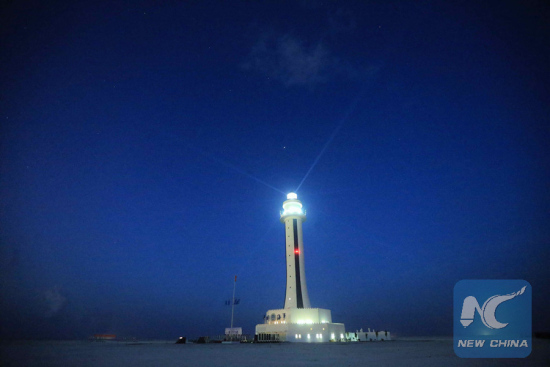
Photo taken on April 5, 2016 shows the lighthouse on Zhubi Reef of Nansha Islands in the South China Sea, south China. (Xinhua/Xing Guangli)
As an outsider in the South China Sea issue, Japan has tried everything to get involved. However, such behavior has only led to more trouble on multiple occasions and is self-defeating; moreover, it has revealed Japan's hidden agenda.
During their recent visits to Europe and Southeast Asia, Japanese Prime Minister Shinzo Abe and Foreign Minister Fumio Kishida expressed "concerns" over China's lawful and reasonable construction of civilian and public facilities on the South China Sea islands and reefs, describing it as "militarization."
The accusation from the Japanese side does not hold water. China's construction is not targeted at any other country. Apart from minimum defense facilities, the buildings are primarily civilian in purpose, and serve not only China's interests, but also those of coastal nations in the region and other countries around the world.
For instance, two lighthouses built last year on reefs in the region have helped guide passing vessels from around the world and significantly improved navigation safety.
The Japanese leaders' irresponsible remarks also ignore the fact that the reclamation projects all involve islands belonging to China or its territorial waters.
In fact, China was the first country to discover, name and exploit the resources of the South China Sea islands. China was also the first country that exercised and has continuously exercised sovereign rights and jurisdiction over the islands.
Chinese sovereignty over the South China Sea islands has been formed during the process of peaceful use by the Chinese people and has been established and consolidated through acts of state by successive Chinese central governments.
As for the claim of a threat to the freedom of navigation and overflight in the sea, it is an excuse used by certain countries. China has never impeded the normal passage of global trade vessels in the region. Facts speak louder than words.
Every year, more than 100,000 vessels pass through the sea unimpeded, despite the complicated territorial rows between China and some of its neighbors. China has traditionally provided public services in the region, such as radio stations, observatories and lighthouses.
Yet certain countries outside the region or non-claimant countries are making waves, creating tensions and seeking militarization in the region.
The U.S. Navy has several times sailed guided missile destroyers within China's territorial waters, and held frequent large-scale drills with its allies in the South China Sea, flexing its military muscles.
Japan has long had a hand in the South China Sea issue. Last year, it launched a joint military drill with the Philippines in the South China Sea and the two sides have conducted frequent military exchanges since then. Moreover, the Abe administration was willing to enhance military cooperation with Vietnam and other countries.
In fact, the Japanese government itself has moved forward on the road of militarization by adopting new security legislation and seeking to amend its pacifist Constitution.
It is advisable that the Abe administration stop meddling in the South China Sea issue, as this benefits neither Japan nor regional stability.


















































